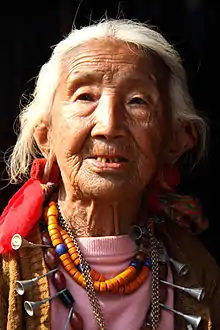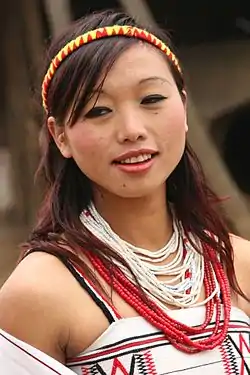Ao Naga
The Ao Nagas are a major Naga[2] ethnic group native to Mokokchung District of Nagaland, Northeast India. Their main territory is from Tsula (Dikhu) Valley in the east to Tsurang (Disai) Valley in the west in Mokokchung district.
Aor | |
|---|---|
 Ao woman in traditional attire | |
| Regions with significant populations | |
| Nagaland | 226,625[1] |
| Languages | |
| Ao language (Mongsen, Chungli) | |
| Religion | |
| Animism (historical), Protestantism (chiefly Baptist) | |
| Related ethnic groups | |
| Other Naga people | |

They were the first Nagas to embrace Christianity and by virtue of this development the Aos availed themselves of the Western education that came along with Christianity. In the process the Aos pioneered among the Nagas in many fields. Christianity first entered into the Ao territory when an American Baptist missionary, Edwin W. Clark, reached an Ao village called Molungkimong in 1872.
Distribution
The total population of Ao Nagas in Nagaland is almost 227,000 according to the 2011 census. Ao Nagas are found in the northern part of Nagaland, mostly in the central Mokokchung District and also a few are found in the adjacent Assam state.
Tzurangkong Range
They lay adjoining the plains of Assam mostly along the valley of Dissai and Jhanzi rivers just before they flow into the plains of Assam. These hillocks are densely covered with bamboos and the climate of the entire range is warm.
Japukong Range
It is the outermost range stretching from north-east to south-west lying to the interior south of Tzurangkong Range.
Jangpetkong Range
This is a parallel range east of the Japukong Range.
Asetkong Range
It is a central range running from east to west but compared to the other ranges, it is the shortest one. This range lies between Melak and Menung rivers, and therefore, it resembles an island. Hence the name Asetkong (Aset meaning Island)
Culture
Religion
The traditional Ao religion is animist, holding that spirits, both benevolent and malicious, must be appealed to and placated through ceremony and sacrifice. Among the Ao deities, Lichaba, the creator, is revered most highly.[3]
Edwin W. Clark, an American missionary traveled to Nagaland in 1872 with the intention to carry out missionary work in the country. Clark approached his work among the Ao as a civilizing mission, seeking to replace traditional culture and language with that of the West. The first family to covert to Christianity was the "Aier" family. The youngest family members now are tamjanminla and narochungla. [4]
Since the 19th century, the majority of Ao have converted to Christianity. Many Ao people, however continue to practice traditional animist festivals and rituals removed from their religious contexts.
Bibliography
- Mills, J. P. (1926). The Ao Nagas. London: Macmillan and Co.
- Smith, William C. (2002). The Ao-Naga tribe of Assam. New Delhi: Mittal.
- Oppitz, Michael, Thomas Kaiser, Alban von Stockhausen & Marion Wettstein. 2008. Naga Identities: Changing Local Cultures in the Northeast of India. Gent: Snoeck Publishers.
- Kunz, Richard & Vibha Joshi. 2008. Naga – A Forgotten Mountain Region Rediscovered. Basel: Merian.
- von Stockhausen, Alban. 2014. Imag(in)ing the Nagas: The Pictorial Ethnography of Hans-Eberhard Kauffmann and Christoph von Fürer-Haimendorf. Arnoldsche, Stuttgart, ISBN 978-3-89790-412-5.
- Wettstein, Marion. 2014. Naga Textiles: Design, Technique, Meaning and Effect of a Local Craft Tradition in Northeast India. Arnoldsche, Stuttgart, ISBN 978-3-89790-419-4.
References
- "A-11 Individual Scheduled Tribe Primary Census Abstract Data and its Appendix". censusindia.gov.in. Government of India. Retrieved 28 October 2017.
- Mills, JP. Ao Nagas (1926).
- Jamir, P. Supong (2016). "The Ao Naga Traditional Indigenous and Religious Beliefs" (PDF). Fazl Ali College Journal. 6.
- naga_family_records_2010
